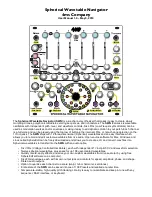
Basic Structure
Internal Structure (System Overview)
124
Owner’s Manual
Arpeggio
This function lets you automatically trigger musical and rhythmic phrases using the current Voice by simply pressing a note
or notes on the keyboard. The Arpeggio sequence also changes in response to the actual notes or chords you play, giving
you a wide variety of inspiring musical phrases and ideas — both in composing and performing.
n
A single Arpeggio type can be played back at the same time even in the Performance, Multi mode, enabling you to play multiple tone generator’s parts
simultaneously.
Arpeggio type categories
The Arpeggio types are divided into 18 categories as listed below.
Arpeggio playback types
The S90 ES features a total of 1787 Arpeggio types divided into 18 categories, each with its own playback type designed for
use with particular types of Voices, as described below.
●
Arpeggios for Normal Voices
Arpeggio types (belonging to the categories except for the DrPC and Cntr) created for use of Normal Voices have the
following two playback types.
n
The two playback types above are not distinguished by the category name or type name. You’ll have to actually play the types and hear the difference.
n
Since these types are programmed for Normal Voices, using them with Drum Voices may not give musically appropriate results.
LCD
Category Name
Description
Seq
Synth Sequence
Various arpeggio phrases suited for synth voices.
ChSq
Synth Chord Sequence
Various rhythmic chord phrases or synth voices.
HySq
Synth Hybrid Sequence
Various arpeggio types programmed so that bass phrases are played with the lower keys and chords or
melodies are played with the midrange and higher keys. These arpeggio types ar e useful for split voice
combinations. In addition, there are also Hybrid Velocity (“HybVel...”) types that feature different phrases for
different velocity ranges, letting you change the arpeggio phrase depending on how str ongly you play the
keyboard.
APKb
Acoustic Piano & Keyboard
Various arpeggio types suited for piano and other keyboar d voices, such as electric piano and clav.
Orgn
Organ
Various arpeggio types suited for organ voices.
GtPl
Guitar & Plucked
Various arpeggio types suited for guitar and harp voices.
GtKM
Guitar - Keyboard Mega Voice
Various arpeggio types suited for guitar Keyboar d Mega voices (see note below).
Bass
Bass
Various arpeggio types suited for bass or synth bass voices.
BaKM
Bass - Keyboard Mega Voice
Various arpeggio types suited for bass Keyboar d Mega voices (see note below).
Strn
Strings
Various arpeggio types suited for strings and pizzicato voices.
Bras
Brass
Various arpeggio types suited for brass voices.
RdPp
Reed & Pipe
Various arpeggio types suited for saxophone and fl ute voices.
Lead
Synth Lead
Various arpeggio types suited for synth lead voices.
PdMe
Synth Pad & Musical FX
Various arpeggio types suited for synth pad voices and special musical ef fects voices, including percussive
sounds.
CPrc
Chromatic Percussion
Various arpeggio types suited for chromatic percussion voices.
DrPc
Drum & Percussion
Various arpeggio types suited for drum and per cussion voices (drum kits).
Comb
Combination
Various arpeggio types suited for Per formances. These are combination arpeggios, with separate phrases
suitable for drum voices, bass voices, and chor d/melody instruments.
Cntr
Control
Various arpeggio types programmed primarily with Control Change and Pitch Bend data. These arpeggio
types change the tone or pitch of the sound, rather than play specifi c notes. In fact, some types contain no
note data at all. When using a type of this categor y, set the KeyMode parameter to “direct” in each mode.
Playback only of the played notes
The Arpeggio is played back using only the played note and its octave notes.
Playback of a programmed sequence
according to the played chord
These Arpeggio types have the several sequences each of which is suited for a certain chord type. Even if you
press only one note, the Arpeggio is played back using the programmed sequence — meaning that notes other
than the ones you play may be sounded. Adding notes to those already held changes the sequence
accordingly — in other words, the arpeggio plays back according to the chord you play.




































